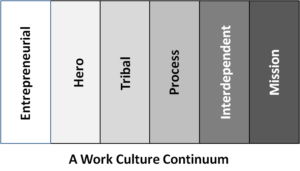Table of Contents
| Foreword & Introduction |
| Part One – Work Culture Framework |
| (Un) Fair Warning |
| Work Culture Framework |
| Entrepreneurial |
| Hero |
| Tribal |
| Process |
| Interdependent |
| Mission |
| Part Two – Work Culture Model |
| Socio-Cultural Model |
| Work Culture Model |
| Part Three – Work Culture Characteristics |
| Learning to See |
| Six Work Culture Dials and Levers |
| Three Work Culture Values |
| Hierarchy of Needs – Expanded |
| Alignment and Imbalances |
| Spin Dynamics |
| Resistance |
| Seeing Self |
| Part Four – Your Change Initiative |
| A Better Way |
| A Change Plan |
| Sustainment |
| Work Culture Architects |
| Model Miscellanea |
| Part Five – Change Stories |
| Level One Change Stories |
| Level Two Change Stories |
| Level Three Change Stories |
| Part Six – Epilogue |
| Fear |
| Appendix |
| Index |
| Warnings |
| Secrets |
| Some Tool Mapping |
Introduction:
“Culture eats strategy for breakfast.” — Peter Drucker
“All organizations are perfectly designed to get the results they are now getting.” –Tom Northup

There is nearly universal acknowledgement that insufficient capitalization is the most significant factor that affects success or failure in business. In second place is work culture. It’s this second factor that prompts leaders to declare their organization needs a positive, constructive, and productive work culture to solve the crisis du jour—and they’re correct!
What happens then is that most leaders turn to strategies, tactics, and analysis, then do what they would normally do anyway. That makes my head spin.
Why declare a need and then ignore it? Is it justification? Is it rationale for another course of action? Don’t they know what to do?
Why does it seem so hard to fix things when, after years of hard work, you finally reside in the office of power?
Perhaps, as has been so well said before, “the soft stuff is the hard stuff.” I take this to mean that some problems are hardware-based or process-based and as such have clear fixes. But larger scale issues require larger scale solutions, which in turn involve more and more people. So the ‘soft stuff’ skill of leading and aligning people really becomes the ‘hard stuff’ to achieve in organizations.
The higher you go in the organization, the more you need to be equipped as a leader to face the challenges of those higher levels.
Often issues that seem so clearly right or wrong suddenly become shades of gray, with mitigating circumstances, involving constituent groups holding competing interests, that may not be aware of the special situation that exists in a context that …
Whew!
How can anyone lead through that and expect to make lasting change!
Marshall Goldsmith’s notion of “what got you here won’t get you there” seem right on target.
Where does one turn for help? And, there’s a bigger question: “Help on what?”
As a former Chief Learning Officer I discovered that in spite of good training materials and infrastructure most employees turn to their coworkers and ask, “How do I do this?” Leaders are like that when they don’t know the answer, or worse, don’t know the question. However, instead of turning to the organization they often turn to other leaders. They join peer groups, executive clubs, chambers of commerce, and other organizations where they might get help while saving face.
I get it. It’s important in some situations for a leader to be seen as “someone who knows.”
Other times leaders go to conferences on processes, techniques, and solutions to get new ideas. And it isn’t just sanctioned leaders, either. Individuals who are passionate about making things better go to these things, too, as did I. They were fun; sometimes they were a “boondoggle” but often they added some value to my change-process utility belt, like the Batman of change agency.
There are so many consultants out there with so many ideas and processes and tools, all trying to make a living. And some are trying to make a difference (I admit that’s a value I hold).
I did a recent search on work and organizational culture and found little information, but did discover these topics:
| Lean or Six-Sigma culture | Competitive culture |
| Military culture (command & control) | People-focused culture |
| Culture of accountability | Fear-based culture |
While these topics can provide good guidance when the time and circumstance are right, Einstein’s words seem particularly instructive.
“We cannot solve our problems with the same level of thinking that created them.”
–Allbert Einstein
These topics address certain aspects of work culture, but they skip or avoid the work culture system altogether.
- What’s the system they all fit into?
- Why does one work and not another?
- Why can’t we just import a successful work culture?
- What stops us from changing in a systemic way?
- What’s the higher level of thinking required to solve this?
In short, what’s work culture and how does it affect all of this?
If we don’t ask that question, then leaders will be easily seduced by consultant promises, not unlike the king and weavers in “The Emperor Has No Clothes”, the tale by Hans Christian Andersen. We must find a way to address the ethereal nature of work culture because we can see its effects and results in action, even if we can’t see the invisible force itself.
This book sets itself a lofty goal—to deliver a model to help understand work culture. It may fall short, but that won’t stop me (or you) from learning and trying to improve things in a way that makes a difference.
Work Culture book is available now! Click on the link below.
Copyright © 2016 Working Change LLC. All Rights Reserved.

